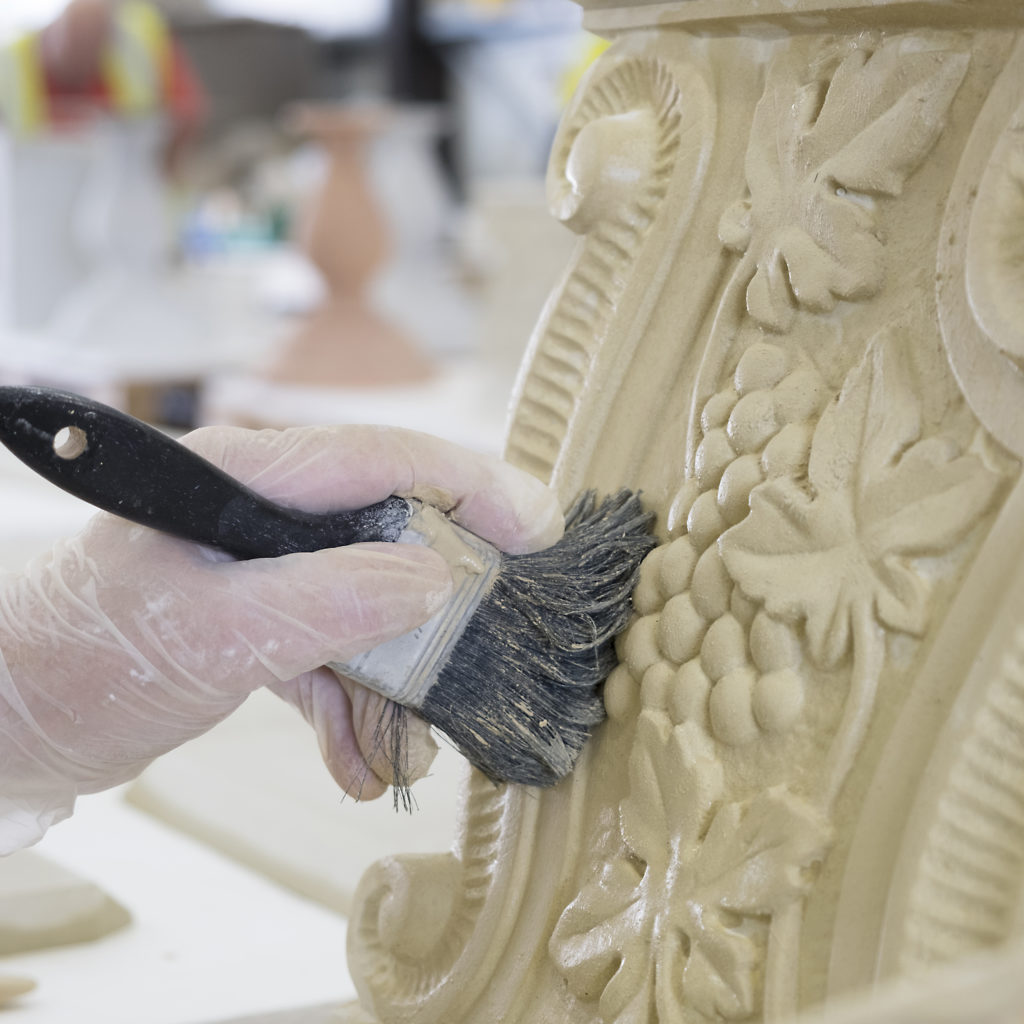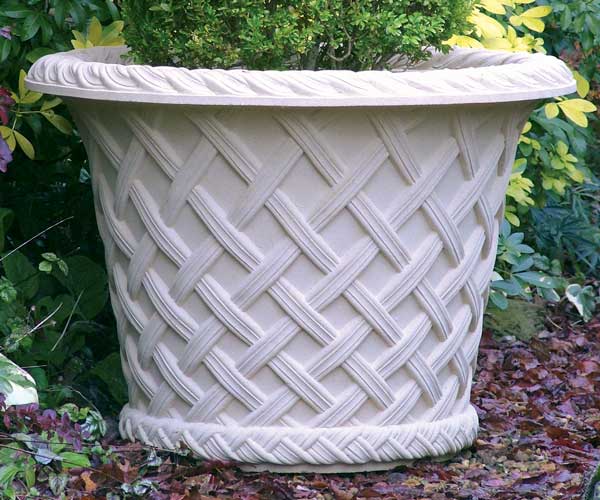- Home
- Blogs and News
- Blog
- 5 Ways To Look After Your Haddonstone Home and Garden Designs
5 Ways To Look After Your Haddonstone Home and Garden Designs
We receive many calls from our clients about how they can best look after their treasured Haddonstone Home and Garden stonework designs. In our latest blog, we answer five of the most popular questions that you have been asking our team.
1. Cleaning – how can I safely clean my stonework?
Cast stone is an incredibly strong and durable material so it needs very little looking after, however, by using a few simple and inexpensive cleaning methods, you can ensure that your designs remain as attractive as the day you purchased them.
- Take care to remove any build-up of dust, dirt and grime
- Use a gentle, non-invasive method such as cleaning your cast stone with fresh, clean water before applying a mild, environmentally friendly detergent with a not too abrasive brush
- A power washer should always only be used on a very low pressure setting and the nozzle must constantly be moved to prevent any localised damage.
Before undertaking any cleaning, it is worth considering what your design may look like after it has been cleaned. Like natural stone, cast stone weathers differently depending on where it is located and how long it has been exposed to the elements. If the front aspect of your design is in direct sunlight for the majority of the year and the back is mainly shaded, both will weather inconsistently and any cleaning will only enhance that contrast. This does mean however that your cast stone design is truly unique and will display its own variations in texture and colour.
What are the best cleaning methods?
We always recommend testing the following cleaning methods on a small, inconspicuous area first before continuing to cleaning larger visible areas.
Firstly, remove any heavy encrustations on your stonework by scraping away moss, lichen and built-up dirt with a dry sponge or a soft bristle brush. Always take great care not to cause localised damage to the outer surface by rubbing the surface too harshly.
Next, apply a gentle cleaning method such as washing your cast stone with fresh, clean water to remove further top-level dirt and blemishes. This can sometimes be enough to simply improve the appearance of your stonework and is especially the case with newer designs, or those that have not been exposed to months of inclement weather.
Judicious use of a not too abrasive brush applied using a soft, circular motion and with a mild, environmentally-friendly detergent should remove most stains without scratching your design, or for the need to use stronger proprietary chemicals and abrasive cleaners.
A power washer can be used on really tough, built-on grime, but always remember to use a very low-pressure setting and constantly move the nozzle from a distance to prevent damage.
2. How can I look after my stonework this winter?
Taking care of self-contained fountains this winter
Whilst all Haddonstone water features are frost resistant, they do require some protection during the colder months. It is important to prepare your water feature for severe freezing conditions that can cause significant damage, particularly to the electrical pump.
Always remember to drain down your water feature each year until any risk of hard frost has passed. This will prevent the water from freezing inside the bowl which can potentially cause cracking to the stonework – we find that this is particularly important for wall bowl and trough fountains.
During mild periods of frost, you can simply place a tennis ball into your fountain bowl to continually agitate the surface and prevent the water from freezing. Dismantling the pump and giving it a thorough clean each year will ensure it works efficiently when you next use it during the warmer months.
Empty smaller fountains with a sponge before covering them to prevent them refilling with rainwater. Fountain covers are a great way to protect your fountain from the elements, as well as fallen leaves and garden debris.
Protecting bird baths during winter
Like water features, bird baths require some protection during the colder months and adding a tennis ball to your bird bath will prevent it from freezing in the same way that it will stop your garden fountain from doing so.
We recommend taking care of our feathered friends by regularly filling your bird bath with fresh, clean drinking water during the winter. Line your bird bath with a plastic sheet or a strong bin bag, which can simply be lifted out of the bird bath should the water freeze over. Always avoid using hot water as this may crack the stone.
Finally, avoid the use of chemicals at all costs – whilst abrasive cleaners can help cleanse your bird bath of dirt and grime, they are poisonous to birds and may even prevent their feathers from being waterproof.
3. Which composts should I use in my Haddonstone planters?
Our extensive range of garden planters features many different styles, sizes and colours, offering you a wide choice, whatever garden you may own. We are often asked which composts are best to use in our planters to prevent staining which can be difficult to clean.
Here are our tips for choosing the right compost for your Haddonstone design:
- Avoid all composts with added fertilisers or those containing peat, this can lead to rust stains developing which can be unsightly and are difficult to clean
- Use a polythene planter liner if using compost containing fertilisers or peat
- Choose a multi-purpose organic compost (ericaceous compost is fine).
4. Weathering – what is it and how can it be achieved?
If you have had the opportunity to visit our Northamptonshire Show Gardens, you will have seen many Haddonstone designs displaying the beautiful signs of ageing and weathering. This naturally occurring effect transforms our cast stone designs into entirely unique pieces that can be treasured for a lifetime. What’s more, weathered and aged Haddonstone designs regularly achieve premium prices at auction.
Depending on where you position your design, over time, it will metamorphose with the elements and become enhanced with natural lichen, moss and a general weathering effect. Cast stone that is located in the shade will develop a quite different effect compared to if it is positioned in a sunny spot. What’s so enchanting about this evolution is that, in addition to their handmade origin, no two pieces of Haddonstone stonework are therefore ever the same!
And if you can’t wait…
Our handy Masonry Weathering Tint will add weathered character to your stonework. Suitable for use on all Haddonstone designs, this easy to apply, water-based liquid tint will achieve an impressive antique look in minutes.
Visit our Weathered Stock page to view a variety of Home and Garden designs that have weathered in our very own Northamptonshire Show Gardens and are available to purchase.
5. I have noticed some hairline cracks on my stonework – should I be concerned?
Our cast stone designs are incredibly robust and the high-quality of our materials means that both our Home and Garden, and our Building and Construction products can easily withstand the elements including frost. However, fluctuating weather temperatures and conditions, more so in the summer months, can sometimes cause cast stone, just like natural carved stone, to be susceptible to slight cracking.
The appearance of hairline cracks and cracks is certainly not uncommon in stone designs, nor is it a new phenomenon, it has been happening for hundreds of years.
The good news is that in almost all cases, cracking is nearly always only aesthetic and is very rarely detrimental to the structural integrity of their designs. So, you can rest assured that your planters, statues and fountains will not fail or fall apart if they develop hairline cracks or cracks.
Why does cast stone crack?
As a material, stone and cast stone products as a matter of course expand and contract with fluctuating weather temperatures and this can result in cracking occurring, particularly when periods of hot weather are followed by periods of heavy rainfall.
In instances where the cracks are not too pronounced, it is extremely likely that as future rain water falls & seeps into the crack that the crack will heal itself, a process known as autogenous healing.
Autogenous healing
“The movement of rainwater through the surface of the mortar joints which dissolves the free lime which is deposited in the micro crack as the water evaporates. The lime subsequently reacts with the carbon dioxide in the air and is converted to calcium carbonate, a cementitious reaction. In a short period of time the hairline crack/s are healed”.



We hope that our guide to looking after your Haddonstone designs is helpful.
For more information and to discuss specific queries, please contact our friendly and experienced team.
Contact us todaySpeak to our team
Whether you’re working on a private residential or large commercial project, or if you are interested in home and garden products, our friendly and expert team are happy to discuss your requirements.






